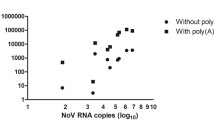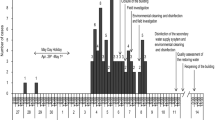Abstract
Norovirus (NoV) is recognized as the most common cause of foodborne outbreaks. In 2014, an outbreak of acute gastroenteritis occurred on a cruise ship in Brazil, and NoV became the suspected etiology. Here we present the molecular identification of the NoV strains and the use of sequence analysis to determine modes of virus transmission. Food (cream cheese, tuna salad, grilled fish, orange mousse, and vegetables soup) and clinical samples were analyzed by ELISA, conventional RT-PCR, qRT-PCR, and sequencing. Genogroup GII NoV was identified by ELISA and conventional RT-PCR in fecal samples from 5 of 12 patients tested (41.7%), and in the orange mousse food sample by conventional RT-PCR and qRT-PCR. Two fecal GII NoV samples and the orange mousse GII NoV sample were successfully genotyped as GII.Pe (ORF 1), revealed 98.0–98.8% identities among them, and shared phylogenetically distinct cluster. Establishing the source of a NoV outbreak can be a challenging task. In this report, the molecular analysis of the partial RdRp NoV gene provided a powerful tool for genotyping (GII.Pe) and tracking of outbreak-related samples. In addition, the same fast and simple extraction methods applied to clinical samples could be successfully used for complex food matrices, and have the potential to be introduced in routine laboratories for screening foods for presence of NoV.

Similar content being viewed by others
References
Baert, L., Uyttendaele, M., & Debevere, J. (2008). Evaluation of viral extraction methods on a broad range of ready-to-eat foods with conventional and real-time RT-PCR for Norovirus GII detection. International Journal of Food Microbiology, 123(1–2), 101–108.
Baert, L., Uyttendaele, M., Stals, A., Van Coillie, E., Dierick, K., Debevere, J., et al. (2009). Reported foodborne outbreaks due to norovirus in Belgium: The link between food and patient investigations in an international context. Epidemiology & Infection, 137(3), 316–325.
Bert, F., Scaioli, G., Gualano, M. R., Passi, S., Specchia, M. L., Cadeddu, C., et al. (2014). Norovirus outbreaks on commercial cruise ships: A systematic review and new targets for the public health agenda. Food and Environmental Virology, 6(2), 67–74.
Bruggink, L. D., Dunbar, N. L., & Marshall, J. A. (2014). Emergence of GII.e as a major ORF 1 norovirus genotype and its associated ORF 2 GII.4 variant forms. Infection, Genetics and Evolution, 22, 157–163.
Demeke, T., & Jenkins, G. R. (2010). Influence of DNA extraction methods, PCR inhibitors and quantification methods on real-time PCR assay of biotechnology-derived traits. Analytical and Bioanalytical Chemistry, 396(6), 1977–1990.
Freeland, A. L., Vaughan, G. H., Jr., & Banerjee, S. N. (2016). Acute gastroenteritis on cruise ships—United States, 2008–2014. MMWR. Morbidity and Mortality Weekly Report, 65(1), 1–5.
Gabbay, Y. B., Siqueira, J. A. M., Lima, I. C. G., Teixeira, D. M., Aragão, G. C., Barbagelata, L. S., et al. (2014). Norovirus outbreak in a cruise ship along the Brazilian coast, March 2011. Revista Pan-Amazônica de Saúde, 5(1), 43–51.
Green, K. Y., Ando, T., Balayan, M. S., Berke, T., Clarke, I. N., Estes, M. K., et al. (2000). Taxonomy of the caliciviruses. Journal of Infectious Diseases, 181(Suppl 2), S322–S330.
Höhne, M., Niendorf, S., Mas Marques, A., & Bock, C. T. (2015). Use of sequence analysis of the P2 domain for characterization of norovirus strains causing a large multistate outbreak of norovirus gastroenteritis in Germany 2012. International Journal of Medical Microbiology, 305(7), 612–618.
Iizuka, S., Oka, T., Tabara, K., Omura, T., Katayama, K., Takeda, N., et al. (2010). Detection of sapoviruses and noroviruses in an outbreak of gastroenteritis linked genetically to shellfish. Journal of Medica Virolorogy, 82(7), 1247–1254.
Isakbaeva, E. T., Widdowson, M. A., Beard, R. S., Bulens, S. N., Mullins, J., Monroe, S. S., et al. (2005). Norovirus transmission on cruise ship. Emerging Infectious Diseases, 11(1), 154–158.
Kageyama, T., Kojima, S., Shinohara, M., Uchida, K., Fukushi, S., Hoshino, F. B., et al. (2003). Broadly reactive and highly sensitive assay for Norwalk-like viruses based on real-time quantitative reverse transcription-PCR. Journal of Clinical Microbiology, 41(4), 1548–1557.
Kim, J. S., Kim, H. S., Hyun, J., Kim, H. S., & Song, W. (2015). Molecular epidemiology of human Norovirus in Korea in 2013. BioMed Research International, 2015, 468304.
Kroneman, A., Vennema, H., Deforche, K., Avoort, H. V. D., Peñaranda, S., Oberste, M. S., et al. (2011). An automated genotyping tool for enteroviruses and noroviruses. Journal of Clinical Virology, 51(2), 121–125.
Lizasoain, A., Tort, L. F., García, M., Gómez, M. M., Leite, J. P., Miagostovich, M. P., et al. (2015). Sewage surveillance reveals the presence of canine GVII norovirus and canine astrovirus in Uruguay. Archives of Virology, 160(11), 2839–2843.
Martella, V., Medici, M. C., De, Grazia S., Tummolo, F., Calderaro, A., Bonura, F., et al. (2013). Evidence for recombination between pandemic GII.4 norovirus strains New Orleans 2009 and Sydney 2012. Journal of Clinical Microbiology, 51(11), 3855–3857.
Morillo, S. G., Luchs, A., Cilli, A., & do Carmo Sampaio Tavares Timenetsky, M. (2012). Rapid detection of norovirus in naturally contaminated food: Foodborne gastroenteritis outbreak on a cruise ship in Brazil, 2010. Food and Environmental Virology, 4(3), 124–129.
Richards, G. P., Watson, M. A., Fankhauser, R. L., & Monroe, S. S. (2004). Genogroup I and II noroviruses detected in stool samples by real-time reverse transcription-PCR using highly degenerate universal primers. Applied Environmental Microbiology, 70(12), 7179–7184.
Rutjes, S. A., Lodder-Verschoor, F., van der Poel, W. H., van Duijnhoven, Y. T., & de Roda Husman, A. M. (2006). Detection of noroviruses in foods: A study on virus extraction procedures in foods implicated in outbreaks of human gastroenteritis. Journal of Food Protection, 69(8), 1949–1956.
Siebenga, J. J., Vennema, H., Renckens, B., de Bruin, E., van der Veer, B., Siezen, R. J., et al. (2007). Epochal evolution of GGII.4 norovirus capsid proteins from 1995 to 2006. Journal of Virology, 81(18), 9932–9941.
Siebenga, J. J., Vennema, H., Zheng, D. P., Vinjé, J., Lee, B. E., Pang, X. L., et al. (2009). Norovirus illness is a global problem: Emergence and spread of norovirus GII.4 variants, 2001-2007. Journal of Infectious Diseases, 200(5), 802–812.
Stals, A., Baert, L., De Keuckelaere, A., Van Coillie, E., & Uyttendaele, M. (2011). Evaluation of a norovirus detection methodology for ready-to-eat foods. International Journal of Food Microbiology, 145(2–3), 420–425.
Sukhrie, F. H., Beersma, M. F., Wong, A., van der Veer, B., Vennema, H., Bogerman, J., et al. (2011). Using molecular epidemiology to trace transmission of nosocomial norovirus infection. Journal of Clinical Microbiology, 49(2), 602–606.
Sukhrie, F. H., Teunis, P., Vennema, H., Bogerman, J., van Marm, S., Beersma, M. F., et al. (2013). P2 domain profiles and shedding dynamics in prospectively monitored norovirus outbreaks. Journal of Clinical Virology, 56(4), 286–292.
Tamura, K., Stecher, G., Peterson, D., Filipski, A., & Kumar, S. (2013). MEGA6: Molecular evolutionary genetics analysis version 6.0. Molecular Biology and Evolution, 30(12), 2725–2729.
Tuan, Z. C., Hidayah, M. S., Chai, L. C., Tunung, R., Ghazali, F. M., & Son, R. (2010). The scenario of norovirus contamination in food and food handlers. Journal of Microbiology and Biotechnology, 20(2), 229–237.
van Beek, J., Ambert-Balay, K., Botteldoorn, N., Eden, J. S., Fonager, J., Hewitt, J., et al. (2012). Indications for worldwide increased norovirus activity associated with emergence of a new variant of genotype II.4, late 2012. Eurosurveillance, 18(1), 8–9.
Vega, E., Barclay, L., Gregoricus, N., Williams, K., Lee, D., & Vinjé, J. (2011). Novel surveillance network for norovirus gastroenteritis outbreaks, United States. Emerging Infectious Diseases, 17, 1389–1395.
Verhoef, L., Kouyos, R. D., Vennema, H., Kroneman, A., Siebenga, J., van Pelt, W., et al. (2011). An integrated approach to identifying international foodborne norovirus outbreaks. Emerging Infectious Diseases, 17(3), 412–418.
Vinjé, J. (2015). Advances in laboratory methods for detection and typing of norovirus. Journal of Clinical Microbiology, 53(2), 373–381.
Wang, X., Yong, W., Shi, L., Qiao, M., He, M., Zhang, H., et al. (2016). An outbreak of multiple norovirus strains on a cruise ship in China, 2014. Journal of Applied Microbiology, 120(1), 226–233.
Wu, X., Han, J., Chen, L., Xu, D., Shen, Y., Zha, Y., et al. (2015). Prevalence and genetic diversity of norovirus in adults with acute gastroenteritis in Houzhou, China, 2013–2014. Archives of Virology, 160, 1705–1713.
Xerry, J., Gallimore, C. I., Iturriza-Gómara, M., & Gray, J. J. (2009). Tracking the transmission routes of genogroup II noroviruses in suspected food-borne or environmental outbreaks of gastroenteritis through sequence analysis of the P2 domain. Journal of Medical Virology, 81(7), 1298–1304.
Zheng, D. P., Ando, T., Fankhauser, R. L., Beard, R. S., Glass, R. I., & Monroe, S. S. (2006). Norovirus classification and proposed strain nomenclature. Virology, 346(2), 312–323.
Acknowledgements
The authors thank the Enteric Diseases Laboratory of Adolfo Lutz staff, Antonio Erculiani Junior for technical assistance with the sequencing reaction, and Sirlene Henrique Rodrigues Silva for laboratorial technical assistance. The authors are grateful to the Centers for Surveillance (CVE), São Paulo State Health Department; and the Brazilian National Agency of Sanitary Surveillance (ANVISA) for assistance in sample collection and epidemiological data.
Authors’ contribution
S.G.M., A.L., and M.C.S.T.T. conceived and designed the study; SGM performed the ELISA, RNA extraction, and RT-PCR assays; S.G.M., A.L., and A.C. performed the molecular typing of the strains; A.L. and A.C. performed the sequencing edition and phylogenetic analysis; S.G.M., A.L., A.C., and R.C.C. analyzed the data; A.L wrote the manuscript. All authors contributed to the preparation and revision of the manuscript, read and approved the final version. S.G.M., A.L., and M.C.S.T.T. are guarantors of the paper.
Author information
Authors and Affiliations
Corresponding authors
Ethics declarations
Conflict of interest
None declared.
Ethical approval
This study was carried out in accordance with the Declaration of Helsinki as revised in 2000, and approved by the Ethics Committee of the Adolfo Lutz Institute, São Paulo, Brazil (88D/2009). Study participants were not required to provide informed consent as this study was considered by the Ethics Committee to be part of routine surveillance activities.
Additional information
Simone Guadagnucci Morillo and Adriana Luchs have contributed equally to this work.
Rights and permissions
About this article
Cite this article
Morillo, S.G., Luchs, A., Cilli, A. et al. Norovirus GII.Pe Genotype: Tracking a Foodborne Outbreak on a Cruise Ship Through Molecular Epidemiology, Brazil, 2014. Food Environ Virol 9, 142–148 (2017). https://doi.org/10.1007/s12560-016-9272-2
Received:
Accepted:
Published:
Issue Date:
DOI: https://doi.org/10.1007/s12560-016-9272-2




